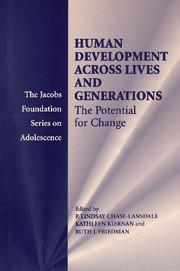Book contents
- Frontmatter
- Contents
- Figures and Tables page
- Contributors
- Foreword
- Acknowledgments
- HUMAN DEVELOPMENT ACROSS LIVES AND GENERATIONS
- Part I Introduction and Overview
- 1 Introduction
- 2 Life-Course Development: The Interplay of Social Selection and Social Causation within and across Generations
- Part II Human Capital
- Part III Partnership Behavior
- Part IV Psychological Health and Development
- Part V Conclusion
- Index
2 - Life-Course Development: The Interplay of Social Selection and Social Causation within and across Generations
from Part I - Introduction and Overview
Published online by Cambridge University Press: 12 October 2018
- Frontmatter
- Contents
- Figures and Tables page
- Contributors
- Foreword
- Acknowledgments
- HUMAN DEVELOPMENT ACROSS LIVES AND GENERATIONS
- Part I Introduction and Overview
- 1 Introduction
- 2 Life-Course Development: The Interplay of Social Selection and Social Causation within and across Generations
- Part II Human Capital
- Part III Partnership Behavior
- Part IV Psychological Health and Development
- Part V Conclusion
- Index
Summary
Basic and applied scientists who study psychosocial influences on human development confront a similar challenge, which is to conduct research that can achieve two goals. First, we need to conduct research that can separate the effects of persons on their environments (i.e., self-selection processes) from environmental effects on the person (i.e., social causation processes). Second, in order to understand the origins of well being and dysfunction within and across generations, we need to conduct research that can differentiate environmental effects on persons from genetic effects. My aim in this chapter is to articulate why these goals are important, and to illustrate how these goals can be tackled in the Service of carrying out policy-relevant research. The chapter is divided into two broad sections. First, I will focus on self-selection processes, where I will emphasize three inter related points, namely (1) that selection effects pose a formidable challenge for policy initiatives, (2) that selection effects have compositional consequences that are important to consider when designing interventions, and (3) that selection effects need to be understood and analyzed, not simply controlled statistically. Second, I will focus on social causation processes, where I will demonstrate that, paradoxically, genetic designs can provide especially valuable information about how socioenvironmental influences shape children's development.
Self-Selection Processes across the Life Course
A long-standing question in the social sciences concerns the source of the relation between social circumstances and individual psychology. Do social circumstances alter individual psychology or do psychological characteristics lead people into their social circumstances? For over fifty years, scientific battles have been waged over these two alternatives. Research in the “selection” tradition argues that people enter environments selectively, sometimes by choice or more often by virtue of constraints imposed by their psychological characteristics. Alternatively, research in the “social causation” tradition argues that socioenvironmental conditions lead people to develop certain unique psychological attributes. These competing explanations have been applied to account for the persistence of observed inequalities in health (both physical and psychological) across the life course (intragenerational continuity) and across generations (intergenerational continuity). Further, these two competing explanations also imply competing recommendations for interventions to enhance health and well-being. Not surprisingly, it is generally agreed that Republicans and Tories favor “selection” arguments and Democrats and Labourites favor “social causation” arguments. Partisanship aside, it is important to appreciate the consequential nature of selection effects.
- Type
- Chapter
- Information
- Human Development across Lives and GenerationsThe Potential for Change, pp. 8 - 28Publisher: Cambridge University PressPrint publication year: 2004
- 4
- Cited by

